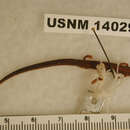Description
provided by AmphibiaWeb articles
This is a moderately large species; adult standard length averages 22.5 mm in eight males (range 19.0-24.5) and 25.5 mm in nine females (range 21.8-29.5). The head is of moderate width; SL averages 7.2 times head width in males (range 6.7-7.9) and 7.5 times head width in females (range 7.1-7.9). Snouts are rounded to bluntly pointed. Nostrils are large and elongate; the mean ratio of major axis to minor axis is 1.3 in males (range 1.1-1.3) and 1.5 in females (range 1.2-1.9). The eyes are moderately protuberant and extend only slightly beyond the margin of the jaw in ventral view. A suborbital groove intersects the lip on each side of the head. There are 1-2 premaxillary teeth in males (mean 1.9) and 4-7 in females (mean 5.4). Vomerine teeth average 6.5 in males (range 4-10) and 8.0 in females (range 4-10). Maxillary teeth average 13.9 in males (range 7-19) and 22.6 in females (range 17-29). Limbs are of moderate length; limb interval averages 4.4 in males (range 3.5-5.5) and 5.2 in females (range 4-6). Hands and feet of adults are moderately large, with well defined, rounded digital tips on the two (hand) and three (feet) longest digits. The tail is relatively short and stout; mean SL divided by tail length equals 1.12 in six females (range 1.00-1.21) and 1.16 in the only male reference specimen with an intact tail. The mental gland is large and raised, longer than broad, and characteristically unpigmented; the parotoid gland is discrete. Alcohol-preserved specimens have a tan to brown dorsal stripe bordered laterally by a dark line of pigment. Many have a herringbone pattern on the stripe. The venter is gray to gray-brown and lighter than the dorsum. There is extensive white flecking ventrally, particularly in the gular region and often extending onto the ventrolateral margins of the belly. There are no data available on the coloration in life (Hanken and Wake 1998).
Distribution and Habitat
provided by AmphibiaWeb articles
Thorius schmidti is known only from the type locality and adjacent forest localities west of the village of Zoquitlán in southern Puebla, Mexico. The recorded elevational range is 2560 to 2760 m. It is an exclusively terrestrial species; according to field notes by J. Hanken (18 Feb. 1976), specimens from 9 km W of Zoquitlán were collected on the ground of a steep, shaded, east-facing slope within dense pine-oak forest with abundant litter of pine needles (Hanken and Wake 1998).
Thorius schmidti: Brief Summary
provided by wikipedia EN
Thorius schmidti, commonly known as Schmidt's pigmy salamander, is a species of salamander in the family Plethodontidae. It is endemic to Mexico and only known from near the village of Zoquitlán in the Sierra Madre de Oaxaca of southern Puebla, possibly also from Oaxaca. It is named after Karl Patterson Schmidt, American herpetologist.
It is an uncommon leaf-litter species inhabiting dense pine-oak forest at elevations of 2,560–2,760 m (8,400–9,060 ft) asl. It is threatened by habitat loss caused by logging and expanding agriculture and human settlements.
- license
- cc-by-sa-3.0
- copyright
- Wikipedia authors and editors

